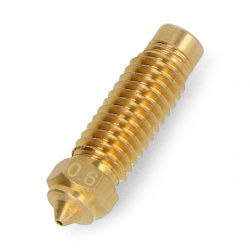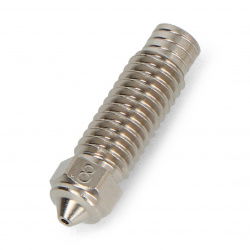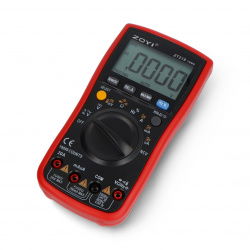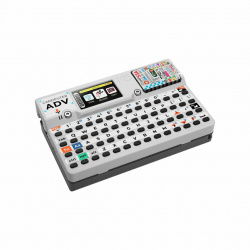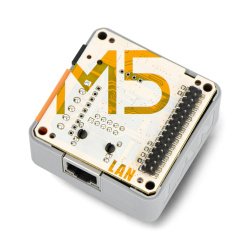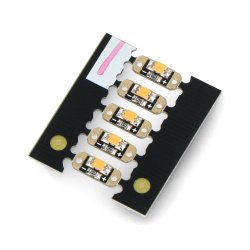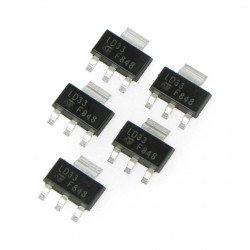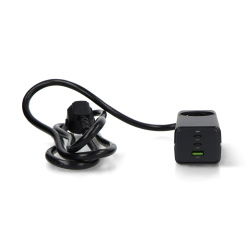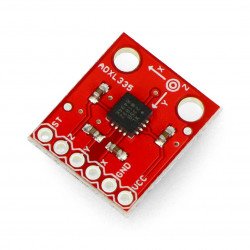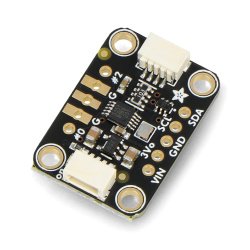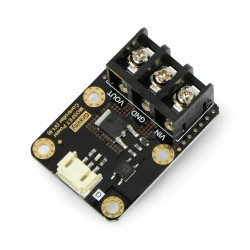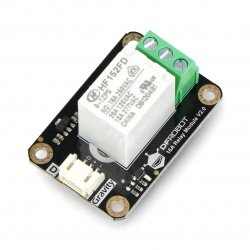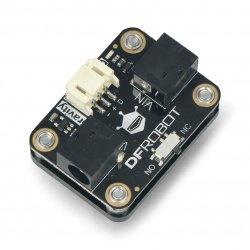- New
Gravity - relays
Gravity: MOSFET Power Controller 5-36V/20A
A switch that allows you to control a device requiring a large current by using a microcontroller. The module works with voltage from 5 V to 36 V with the current consumption...DFRobot Gravity v2.0 - relay 1 channel - 277VAC / 16A contacts - 5V coil
Module with relay that allow for the control of the actuators through the ports of the microcontroller. The kit includes a cable adapted to DFRobot IO Expansion Shield.DFRobot Gravity - relay 1 channel - 10A/277VAC contacts - 5V coil
Module with relay that allows for the control of the actuators consuming the current of up to 12 A for the voltage of 125 V or 10 A for 277 V through the ports of the...Gravity - snap-on 10A/250VAC magnetic relay - for Arduino and ESP32 - DFRobot DFR0996
Magnetic latching relay 10 A / 250 V AC from DFRobot. Compared to other relays, it is distinguished by the fact that it needs two digital pulse signals to switch the ON /...Gravity - relay module - with DC-USB adapters - DFRobot DFR0643
Relay module included with DC adapters manufactured by DFRobot. It has a built-in Gravity connector , which allows to reduce the number of connection wires, making it...See also
- Gravity - starter kits
- Gravity - base hats
- Gravity - accelerometers and gyroscopes
- Gravity - actuators
- Gravity - gas & dust sensors
- Gravity - medical sensors
- Gravity - distance sensors
- Gravity - current sensors
- Gravity - temperature sensors
- Gravity - force sensors and limit switches
- Gravity - light and colour sensors
- Gravity - LED
- Gravity - encoders and potentiometers
- Gravity - converters
- Gravity - communication modules
- Gravity - sound modules
- Gravity - buttons, keys and joysticks
- Gravity - cables
- Gravity - displays
Electromagnetic relays and solid-state switches
Electromechanical relays are electromechanical components. In the simplest terms, the principle of operation of a relay is the conversion of electrical energy into mechanical energy. By applying a control voltage to the relay coil, the electric current flowing through its windings creates a magnetic field that attracts a metal anchor. This anchor is mechanically connected to the contacts of the controlled circuit, which, after energizing the relay coil, are closed or opened, depending on the configuration. Another solution, which has a similar purpose as relays but does not contain moving mechanical parts, are solid-state switches based on fast-switching MOSFET transistors. In this case, instead of a coil, we control the application of a control voltage between the gate and source of the transistor, and the control circuit current flows through the drain-source channel.
DPDT-NO, SPST-NC...what is it all about?
In addition to such important parameters as the operating voltage of the control coil and the maximum operating voltage and current of the controlled circuit, the configuration of the controlled circuit contacts is an important parameter that determines the purpose of the relay for a particular application. Relays can control one or more circuits by switching on and off a single coil. Two-coil relays (with two control circuits) are used less frequently. Examples of relay designs by contact configuration are:
- SPST - such a relay has a total of four leads. Two of them are leads for supplying the control coil, and the other two are leads for operating contacts of the controlled circuit. SPST configuration is the simplest possible and allows only for switching on and off a single circuit. Such a relay can be used, for example, to remotely control a bedside lamp.
- SPDT - similar to the SPST configuration relay, you can control a single circuit, but with a difference that it is switchable. Such a relay will come in handy e.g. in a two-channel guitar amplifier as the switching element between the clean and distorted channel.
- DPST - the same contact principle as in the SPST relay, but here, you can simultaneously control the switching on and off of two circuits through a single coil.
- DPDT - The principle of contact operation is the same as in SPDT relay, but here we can simultaneously control switching on and off in two circuits through a single coil.
The second important element in determining the configuration of the relay's contacts is the state of the contacts of the controlled circuit at the time when there is no control voltage applied to the relay's coil. We distinguish between:
- NO - when the voltage on the control coil is off, the contacts of the controlled circuit are open (after the voltage is applied to the control coil, the contacts of the controlled circuit are closed)
- NC - when the voltage on the control coil is off, the contacts of the controlled circuit are closed (when the voltage is applied to the control coil, the contacts of the controlled circuit are open)
































































































































































































































































































































